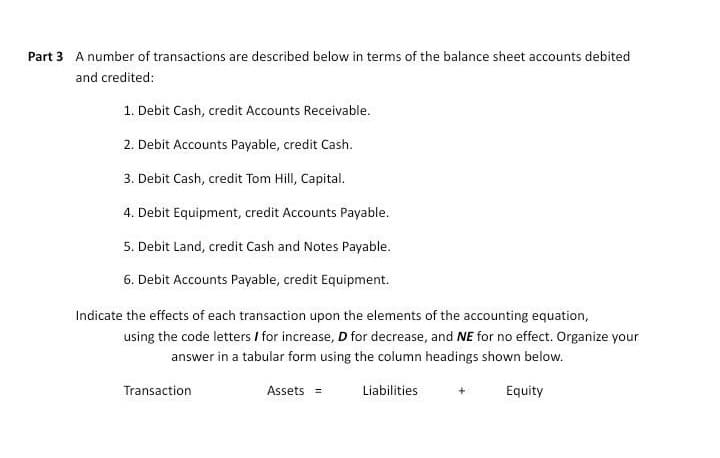Part 3 A number of transactions are described below in terms of the balance sheet accounts debited and credited: 1. Debit Cash, credit Accounts Receivable. 2. Debit Accounts Payable, credit Cash. 3. Debit Cash, credit Tom Hill, Capital. 4. Debit Equipment, credit Accounts Payable. 5. Debit Land, credit Cash and Notes Payable. 6. Debit Accounts Payable, credit Equipment. Indicate the effects of each transaction upon the elements of the accounting equation,
Part 3 A number of transactions are described below in terms of the balance sheet accounts debited and credited: 1. Debit Cash, credit Accounts Receivable. 2. Debit Accounts Payable, credit Cash. 3. Debit Cash, credit Tom Hill, Capital. 4. Debit Equipment, credit Accounts Payable. 5. Debit Land, credit Cash and Notes Payable. 6. Debit Accounts Payable, credit Equipment. Indicate the effects of each transaction upon the elements of the accounting equation,
Chapter4: The Adjustment Process
Section: Chapter Questions
Problem 2PA: To demonstrate the difference between cash account activity and accrual basis profits (net income),...
Related questions
Question

Transcribed Image Text:Part 3 A number of transactions are described below in terms of the balance sheet accounts debited
and credited:
1. Debit Cash, credit Accounts Receivable.
2. Debit Accounts Payable, credit Cash.
3. Debit Cash, credit Tom Hill, Capital.
4. Debit Equipment, credit Accounts Payable.
5. Debit Land, credit Cash and Notes Payable.
6. Debit Accounts Payable, credit Equipment.
Indicate the effects of each transaction upon the elements of the accounting equation,
using the code letters I for increase, D for decrease, and NE for no effect. Organize your
answer in a tabular form using the column headings shown below.
Transaction
Assets =
Liabilities
Equity
Expert Solution
This question has been solved!
Explore an expertly crafted, step-by-step solution for a thorough understanding of key concepts.
This is a popular solution!
Trending now
This is a popular solution!
Step by step
Solved in 2 steps

Knowledge Booster
Learn more about
Need a deep-dive on the concept behind this application? Look no further. Learn more about this topic, accounting and related others by exploring similar questions and additional content below.Recommended textbooks for you

Principles of Accounting Volume 1
Accounting
ISBN:
9781947172685
Author:
OpenStax
Publisher:
OpenStax College

Cornerstones of Financial Accounting
Accounting
ISBN:
9781337690881
Author:
Jay Rich, Jeff Jones
Publisher:
Cengage Learning

Century 21 Accounting Multicolumn Journal
Accounting
ISBN:
9781337679503
Author:
Gilbertson
Publisher:
Cengage

Principles of Accounting Volume 1
Accounting
ISBN:
9781947172685
Author:
OpenStax
Publisher:
OpenStax College

Cornerstones of Financial Accounting
Accounting
ISBN:
9781337690881
Author:
Jay Rich, Jeff Jones
Publisher:
Cengage Learning

Century 21 Accounting Multicolumn Journal
Accounting
ISBN:
9781337679503
Author:
Gilbertson
Publisher:
Cengage

Corporate Financial Accounting
Accounting
ISBN:
9781305653535
Author:
Carl Warren, James M. Reeve, Jonathan Duchac
Publisher:
Cengage Learning

College Accounting, Chapters 1-27
Accounting
ISBN:
9781337794756
Author:
HEINTZ, James A.
Publisher:
Cengage Learning,

Survey of Accounting (Accounting I)
Accounting
ISBN:
9781305961883
Author:
Carl Warren
Publisher:
Cengage Learning